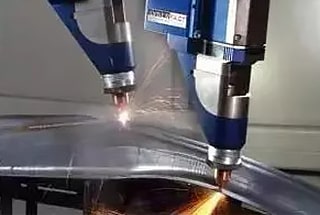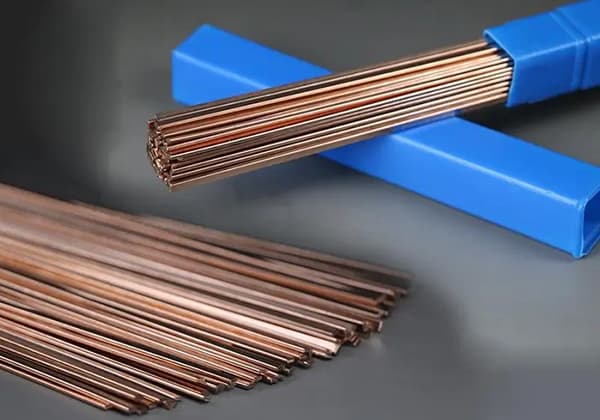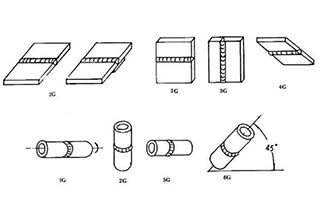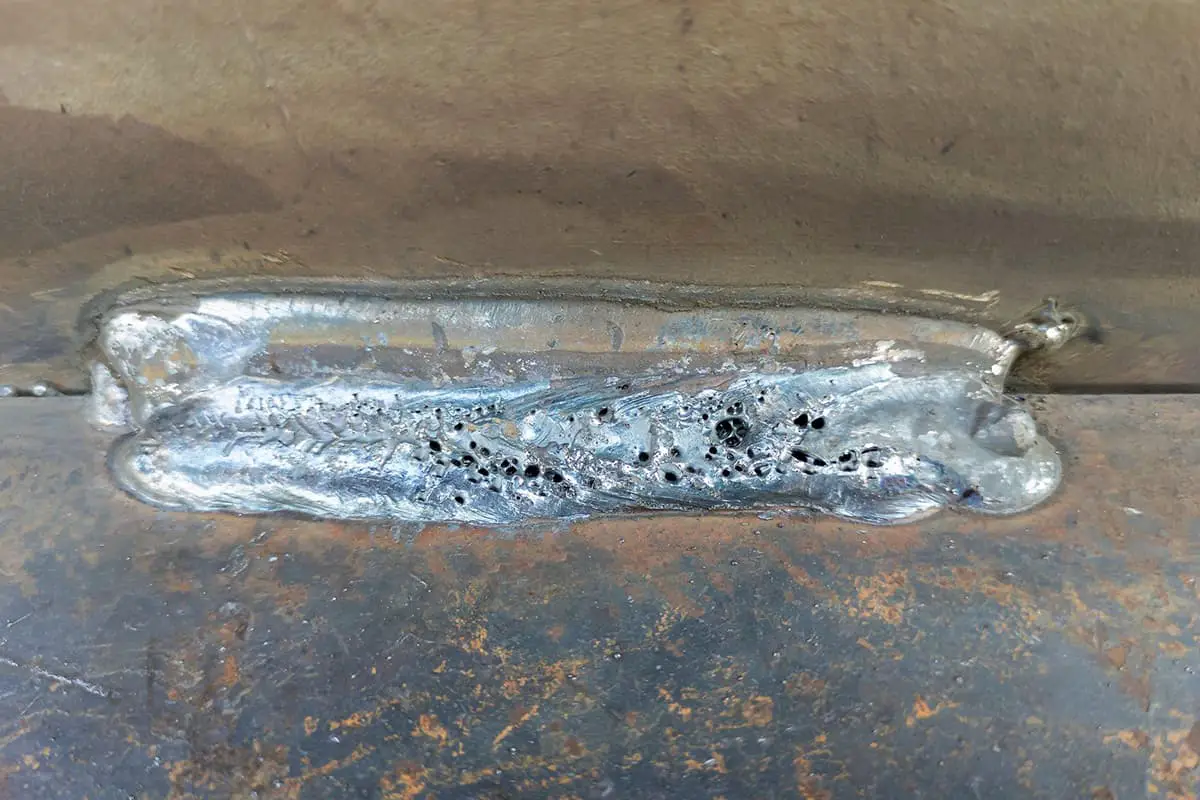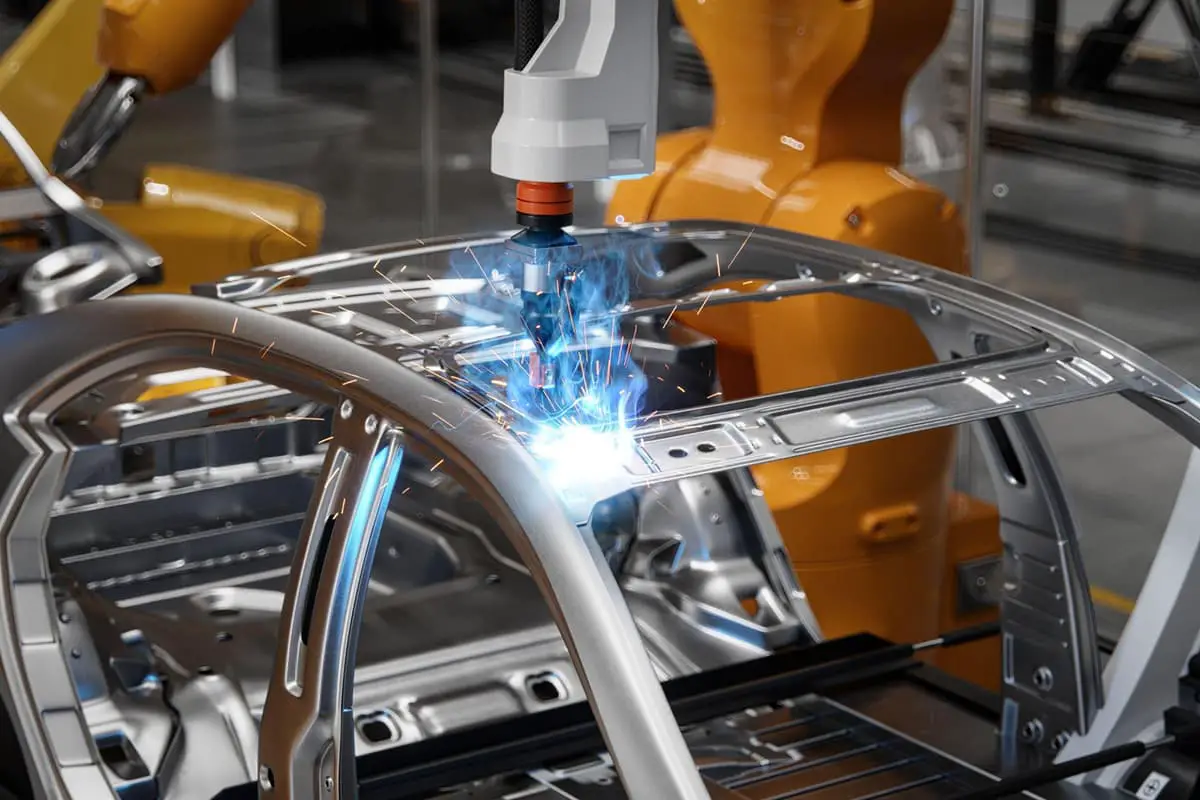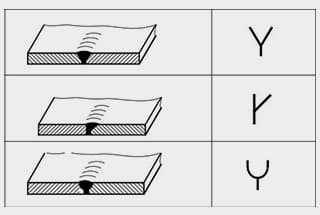
Have you ever wondered about the science behind joining metals without melting them? Brazing is a fascinating process that connects metals using a filler material heated to a specific temperature range. In this article, we’ll dive into the world of brazing, exploring its characteristics, advantages, and various types. Join us as we uncover the secrets of this essential metalworking technique and discover how it shapes the products we use every day.
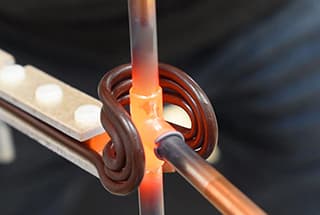
The brazing filler metal is heated to an appropriate temperature, typically above 450°C.
This temperature is higher than the liquidus temperature of the filler metal but lower than the solidus temperature of the base metal.
This heating process promotes wetting of the liquid filler metal on the surface of the base metal and enables the filler metal to fill the brazing joint through capillary action, thus forming a connection between two materials, which may be the same or different.
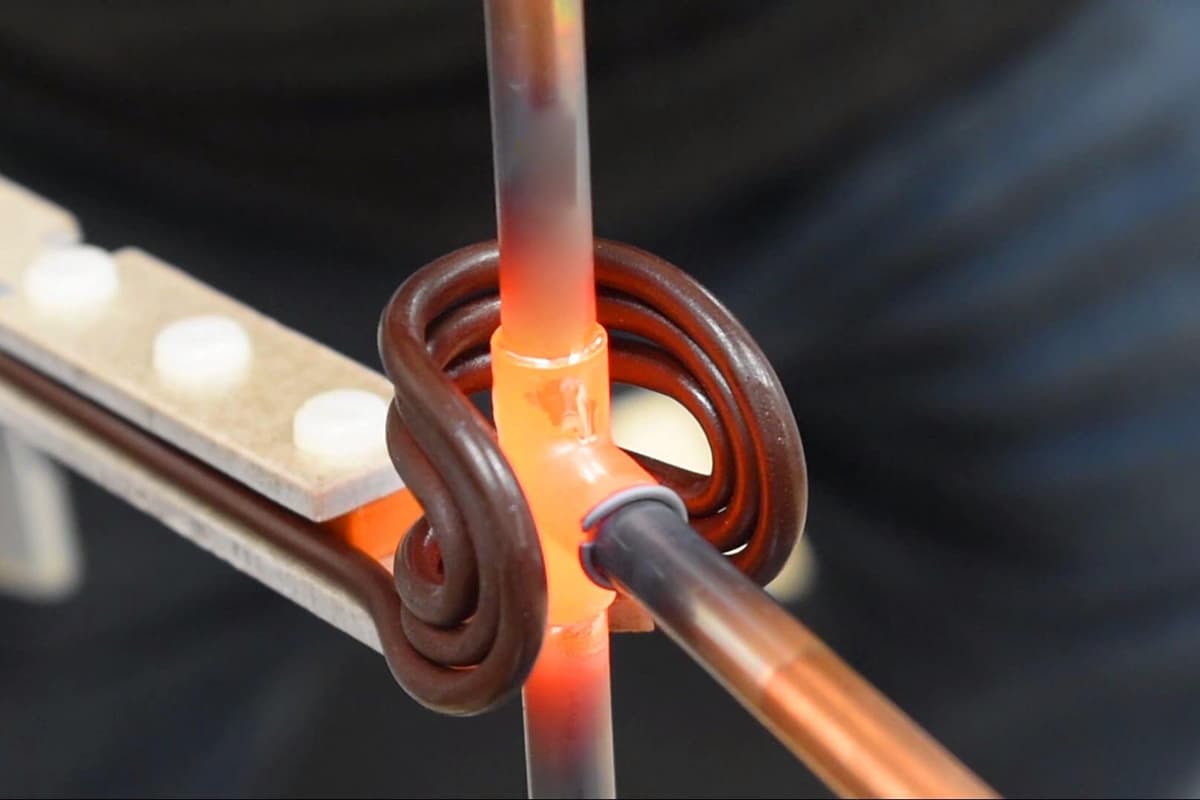
(1) The melting point of the filler metal is lower than that of the base metal, ensuring that the base metal remains intact during the brazing process.
(2) The composition of the filler metal is significantly different from that of the base metal.
(3) The melted filler metal is drawn into and retained in the gap between the base metal components through wetting and capillarity.
(4) The metal bond is established through the mutual diffusion of the liquid filler metal and the solid base metal.
Decomposition of brazing process
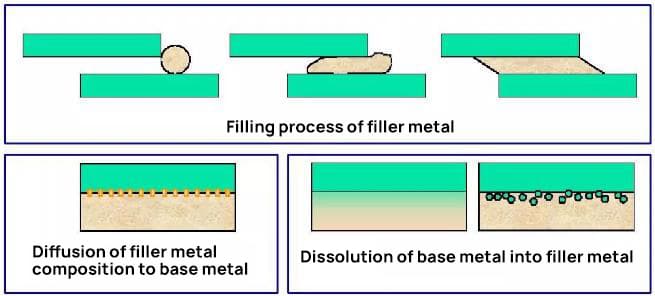
1) Classification according to solder melting point
Below 450 ℃ – Soldering
Above 450 ℃ – Brazing
2) By brazing temperature
High temperature brazing above 800 ℃; 550~800 ℃ is medium temperature brazing;
Low temperature brazing is conducted when the temperature is lower than 500 ℃.
3) By heat source type
Flame brazing, soldering iron brazing, furnace brazing, induction brazing, resistance brazing.
Liquidus: the lowest temperature at which solder is completely liquid;
Solid phase line: the highest temperature at which the filler metal is completely solid;
Wetting effect:
Adhesion is the phenomenon that occurs when a liquid and a solid object stick together after coming into contact.
It can be categorized into immersion wetting, adhesion wetting, and spreading wetting.
In a free state, a liquid will attempt to maintain a spherical shape.
When the liquid comes into contact with a solid, if its cohesion is greater than its adhesion, it will not stick to the solid surface without wetting.
However, if the adhesion of the liquid is stronger than its cohesion, it will be able to adhere to the solid surface once wetting occurs.
The ability of a liquid to stick to a base metal can be measured by the contact angle between the liquid and solid phases.
During brazing, the filler metal’s wetting angle should be less than 20°.
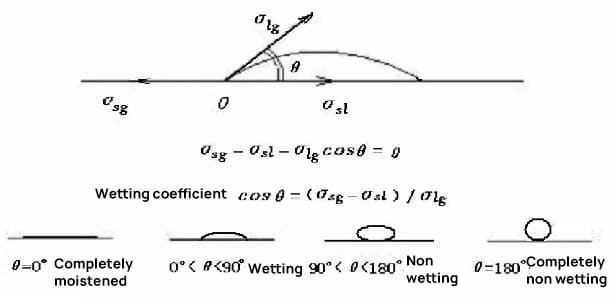
Capillary action:
It is assumed that when two metal plates that are parallel to each other are inserted vertically into an infinite amount of liquid solder, the plates are infinite and the amount of solder is unlimited.
Depending on the wetting properties of the solder on the metal plates, the capillary effect will result in either the situation shown in Figure (a) or the situation shown in Figure (b). If the solder is able to wet the metal plates, the outcome depicted in Figure (a) will occur; if not, the outcome in Figure (b) will occur.
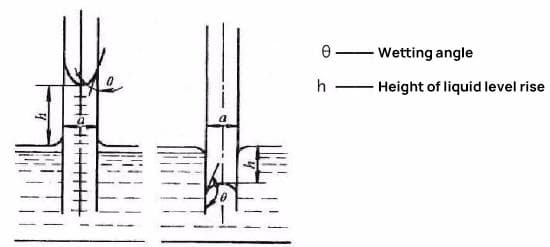
Sn based and Pb based soft solders:
They have good wetting and spreading ability for copper and other metals, and are most widely used in the electronic industry.
Cd based solder:
Mainly cadmium silver alloy, with good heat resistance and corrosion resistance.
Zn based solder
Au based soft solder
Other low melting point soft solders.
Include:
① In (indium) based solder
② Bi (bismuth) base solder
③ Ga (gallium) based solder
Lead-free solder
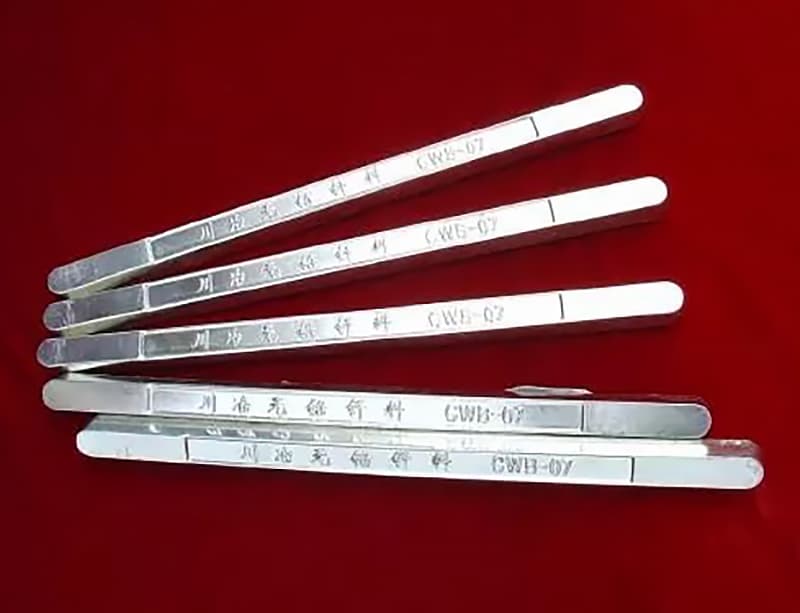
Due to its relatively high strength, brazing filler metal can be used to braze stressed components.
The brazing filler metal includes:
AI based filler metal:
Used for brazing aluminum and aluminum alloys
Ag based brazing filler metal:
It has excellent comprehensive performance and can be used for brazing various metals. It is the most widely used brazing filler metal.
Cu based filler metal:
Copper brazing filler metal: brazing carbon steel and low alloy steel.
Copper zinc solder: various brazing methods are used to weld various metals.
Copper phosphorus filler metal: mainly used for brazing copper and copper alloys, widely used in motor manufacturing and refrigeration equipment.
W-based filler metal:
Excellent performance, can weld various metals.
See also:
Function and performance requirements of brazing flux:
1) Remove the oxide film to create conditions for wetting and spreading;
2) The liquid flux covers the base metal and the solder surface for protection;
3) It plays an interface active role to improve wetting and spreading.
Necessity of removing film during brazing
The oxide film present on the metal surface significantly impacts the wetting and spreading of solder, and must therefore be removed.
The thicker the oxide film, the stronger its bond with the metal matrix, and the higher its thermal and chemical stability, making it more difficult to remove.
Removal can be achieved through the use of solder flux, a gas medium, mechanical methods, or physical methods.
Solder flux not only prevents the oxidation of the workpiece and solder, but also removes the oxide film. It also reduces the surface tension, promoting the flow of the solder and facilitating the formation of the solder joint.
Table 1 Formation Rate of Oxide Film in Dry Air
| Metal | 1 minute | 1 hour | 1 day |
| Stainless steel | 10 | 10 | 10 |
| Iron | 20 | 24 | 33 |
| Aluminum | 20 | 80 | 100 |
| Copper | 33 | 50 | 50 |
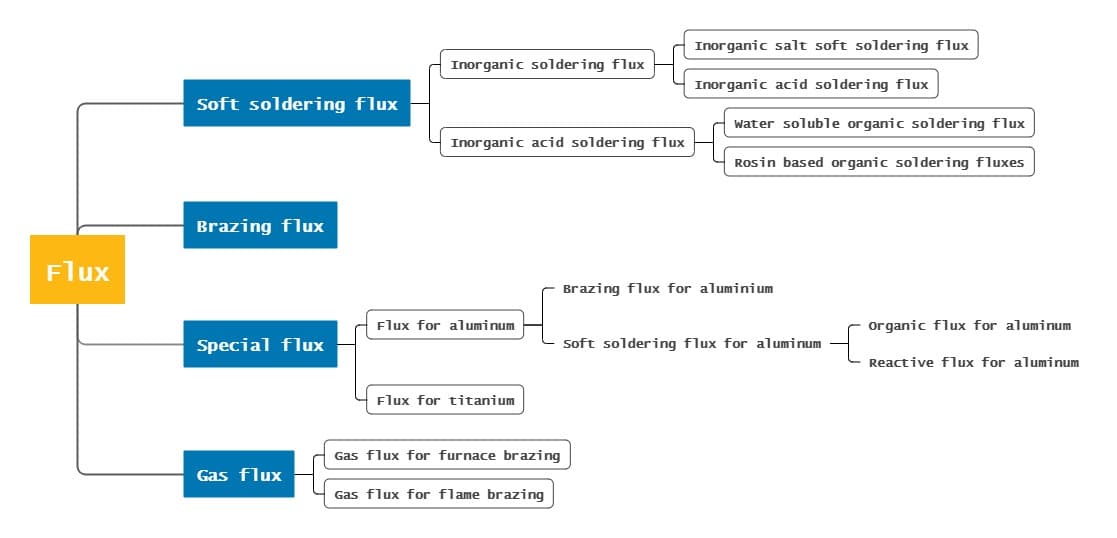
In brazing, the neutral gas used is mainly argon, with nitrogen being used in some cases.
Argon is an inert gas that primarily serves to protect the workpiece, and does not have the capability to directly remove the oxide film.
Some oxide films can be removed through the decomposition of oxides and the reduction, dispersion, and dissolution of the oxide film’s strength through the adsorption of liquid solder.
As shown in the table, the decomposition temperature of most metal oxides is higher than the melting point or even the boiling point of the metal.
It can be concluded that during the brazing process, it is not possible to achieve oxide decomposition simply through heating.
| Oxide | Decomposition temperature (℃) | Oxide | Decomposition temperature (℃) |
| Au2O | 250 | PbO | 2348 |
| Ag2O | 300 | NiO | 2751 |
| Pt2O | 300 | FeO | 3000 |
| CdO | 900 | MnO | 3500 |
| Cu2O | 1835 | ZnO | 3817 |
1. Iron soldering
Features: low temperature
Scope of application:
1. It is applicable to soldering (using tin lead or lead based filler metal) with soldering temperature lower than 300C;
2. Solder flux is required for brazing thin and small parts.

2. Torch brazing, torch soldering
Features: simple, flexible and widely used
Scope of application: generally, neutral flame or slight carbonization flame/general gas torch or special brazing torch (torch can also be used for soft soldering) shall be used to heat the workpiece first:
1. It is applicable to brazing some weldments which are limited by the shape, size and equipment of weldments and cannot be brazed by other methods
2. Automatic flame brazing can be used
3. Weldable steel, stainless steel, hard alloy, cast iron, copper, silver, aluminum, etc. and their alloys
4. Common filler metals include copper zinc, copper phosphorus, silver base, aluminum base and zinc aluminum filler metals

3. Dip brazing, dip soldering
(Salt bath and metal bath, suitable for mass production)

4. Flow soldering, wave soldering, spray soldering
(A variety of metal bath brazing, mainly used for brazing printed circuit boards)

5. Resistance brazing
Extremely fast heating and high productivity.
6. Induction brazing
Fast heating, less oxidation and small brazing.

The brazing production process encompasses several steps including preparation of the workpiece surface prior to brazing, assembly, placement of the filler metal, brazing, post-brazing treatment, and other related processes.
1. Brazed joint design
When designing a brazed joint, the primary consideration should be its strength, followed by the process considerations such as ensuring the dimensional accuracy of the assembly, proper assembly and positioning of the parts, placement of the solder, and the clearance of the brazed joint.
The lap joint is commonly used for brazing joints.
In practical production, for brazing joints made with high-strength silver-based, copper-based, or nickel-based filler metals, the lap length is typically 2-3 times the thickness of the thinner piece.
For soldered joints made with soft solders such as tin-lead, the lap length can be 4-5 times the thickness of the thinner piece, but it should not exceed 15mm.
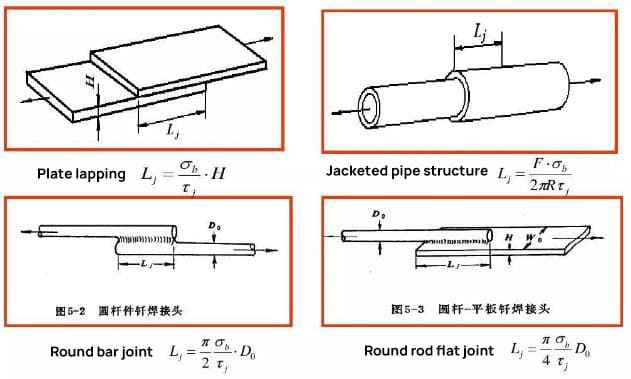
Types of brazed joints
a) Joint form of plate brazing

b) Joint form of T-shape and bevel brazing

c) Joint form of tube or bar and plate
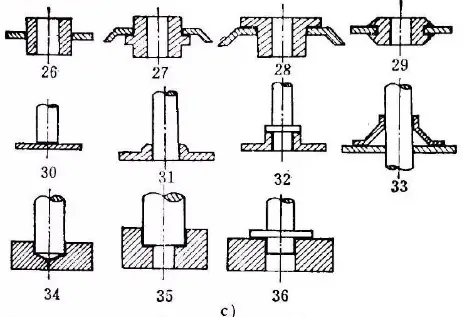
d) Joint form of wire contact brazing

e) Joint form of pipe brazing
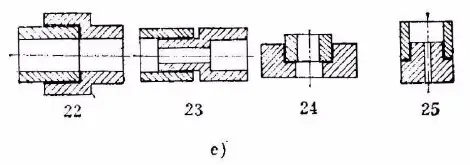
Positioning method of brazed joint

a) Gravity positioning b) Tight fit c) Knurling d) Flanging

e) Flaring f) Spinning g) Die forging h) Necking

i) Undercut j) Slotting and bending k) Clamping l) Positioning pin
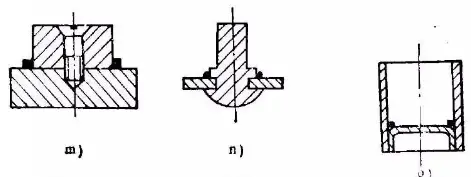
m) Screw n) Riveting o) Spot welding
2. Surface preparation of weldment
Before the brazing process, it is crucial to thoroughly remove any oxide, grease, dirt, and paint from the surface of the workpiece.
In some cases, it may be necessary to pre-coat the parts with a specific metal layer prior to brazing.
(1) Remove oil stain
Oil stains can be removed using organic solvents.
Common organic solvents include alcohol, carbon tetrachloride, gasoline, trichloroethylene, dichloroethane, and trichloroethane.
(2) Oxide removal
Before brazing, the oxide films on the part surface can be processed using mechanical methods, chemical etching methods, and electrochemical etching methods.
3. Assembly and fixing
Solder metals are used in various brazing methods, with the exception of flame brazing and soldering iron brazing, most of which are pre-placed on the joint. The gravity and capillarity of the gap should be utilized as much as possible to encourage the filler metal to fill the gap when placed.
Paste filler metal should be directly applied to the brazed joint, and the powder solder can be mixed with an adhesive before being applied to the joint.
4. Placement method of filler metal
a) Placement of annular solder

b) Placement of foil solder
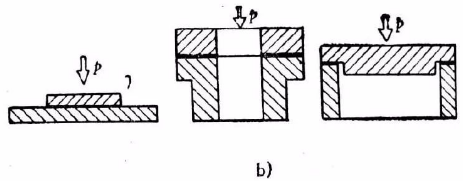
P – pressure applied


